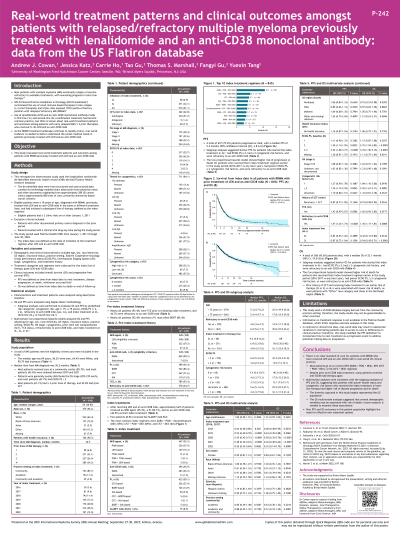Treatment of Relapsed/Refractory Myeloma
Poster Session 2
P-242: Real-world treatment patterns and clinical outcomes amongst patients with relapsed/refractory multiple myeloma previously treated with lenalidomide and an anti-CD38 monoclonal antibody
Thursday, September 28, 2023
12:30 PM - 1:30 PM EEST


Andrew J. Cowan, MD (he/him/his)
Associate Professor
University of Washington, Seattle, WA, USA
Seattle, Washington, United States
Introduction: NCCN Clinical Practice Guidelines in Oncology (NCCN Guidelines®) recommend the use of novel-immune based therapies in late relapse (≥3 prior therapies) and triple-class exposed (TCE)/penta-refractory patients (pts) with multiple myeloma (MM). Limited guidance is provided in pts with early relapsed (1–3 prior therapies) MM regarding anti-CD38 monoclonal antibody (mAb) exposure, with increasing use of lenalidomide (LEN) and an anti-CD38 mAb in 1L/2L (first-/second-line) treatment (Tx). Real-world evidence is needed to better understand Tx patterns and clinical outcomes post-LEN and an anti-CD38 mAb.
Methods: This retrospective cohort study used Flatiron Health electronic medical records from January 1st, 2011 to June 30th, 2022. Pts with MM were included if they were previously treated with LEN and an anti-CD38 mAb in the same or different lines, and had initiated the next line of Tx (index regimen). Descriptive analyses were conducted to assess baseline demographics, clinical factors, Tx history, and index Tx patterns. Progression-free survival (PFS) and overall survival (OS) were estimated using Kaplan–Meier plots. Subgroup analyses of the survival outcomes were conducted by selected risk groups: high-risk cytogenetics (≥1 cytogenetic factors: del 17p, t(4;14), t(14;16), t(14;20), and amplification 1q21), elderly (≥75 years old), ECOG score ≥2, and refractory to anti-CD38 mAbs. Multivariate cox proportional hazard regressions were used to assess the association between baseline pt characteristics and survival outcomes.
Results: Of 845 pts, 96.4% started the index regimen during 2017–2022. The median age at start of index regimen (index date) was 69; 64.4% were White and 15.0% were African American. Most pts (85.7%) were treated in the community setting; 35.5% had high-risk cytogenetics; 18.3% had ECOG score ≥2. Median time from initial MM diagnosis to index date was 36.5 months. Only 6.9% initiated the index regimen at 2L Tx, while 32.1% and 61.1% initiated at 3L and 4L+ Tx, respectively. Most pts (93.4%) were TCE and 44.8% were refractory to an anti-CD38 mAb. Daratumumab (DARA)/pomalidomide (POM)/dexamethasone (DEX) (10.7%), carfilzomib (CAR)/POM/DEX (5.2%), and CAR/DEX (4.7%) were the most frequently used index regimens. The median PFS and OS were 5.3 and 23.1 months, respectively. Those with high-risk cytogenetics, ECOG score ≥2, and refractory to anti-CD38 had shorter survival than their counterparts.
Conclusions: In pts previously treated with LEN and an anti-CD38 mAb, DARA, CAR, and POM-based regimens were most used; however, there is no clear standard of care. Poor survival outcomes in the overall population and certain subgroups highlight the need for novel, effective, and safe agents to address unmet medical needs of this rapidly growing pt population with prior exposure to LEN and an anti-CD38 mAb.
Referenced with permission from the NCCN Clinical Practice Guidelines in Oncology (NCCN Guidelines®) for Multiple Myeloma 3.2023.
Methods: This retrospective cohort study used Flatiron Health electronic medical records from January 1st, 2011 to June 30th, 2022. Pts with MM were included if they were previously treated with LEN and an anti-CD38 mAb in the same or different lines, and had initiated the next line of Tx (index regimen). Descriptive analyses were conducted to assess baseline demographics, clinical factors, Tx history, and index Tx patterns. Progression-free survival (PFS) and overall survival (OS) were estimated using Kaplan–Meier plots. Subgroup analyses of the survival outcomes were conducted by selected risk groups: high-risk cytogenetics (≥1 cytogenetic factors: del 17p, t(4;14), t(14;16), t(14;20), and amplification 1q21), elderly (≥75 years old), ECOG score ≥2, and refractory to anti-CD38 mAbs. Multivariate cox proportional hazard regressions were used to assess the association between baseline pt characteristics and survival outcomes.
Results: Of 845 pts, 96.4% started the index regimen during 2017–2022. The median age at start of index regimen (index date) was 69; 64.4% were White and 15.0% were African American. Most pts (85.7%) were treated in the community setting; 35.5% had high-risk cytogenetics; 18.3% had ECOG score ≥2. Median time from initial MM diagnosis to index date was 36.5 months. Only 6.9% initiated the index regimen at 2L Tx, while 32.1% and 61.1% initiated at 3L and 4L+ Tx, respectively. Most pts (93.4%) were TCE and 44.8% were refractory to an anti-CD38 mAb. Daratumumab (DARA)/pomalidomide (POM)/dexamethasone (DEX) (10.7%), carfilzomib (CAR)/POM/DEX (5.2%), and CAR/DEX (4.7%) were the most frequently used index regimens. The median PFS and OS were 5.3 and 23.1 months, respectively. Those with high-risk cytogenetics, ECOG score ≥2, and refractory to anti-CD38 had shorter survival than their counterparts.
Conclusions: In pts previously treated with LEN and an anti-CD38 mAb, DARA, CAR, and POM-based regimens were most used; however, there is no clear standard of care. Poor survival outcomes in the overall population and certain subgroups highlight the need for novel, effective, and safe agents to address unmet medical needs of this rapidly growing pt population with prior exposure to LEN and an anti-CD38 mAb.
Referenced with permission from the NCCN Clinical Practice Guidelines in Oncology (NCCN Guidelines®) for Multiple Myeloma 3.2023.
